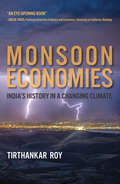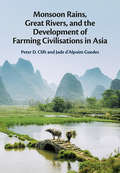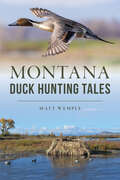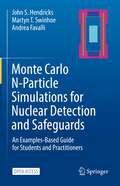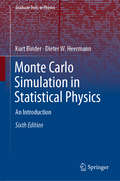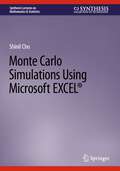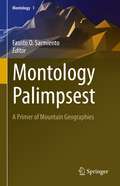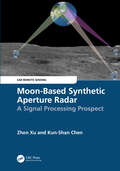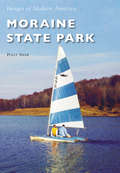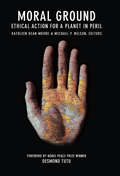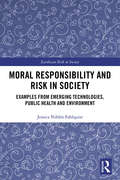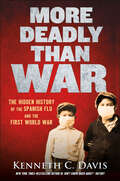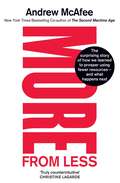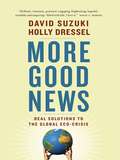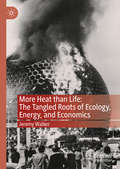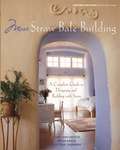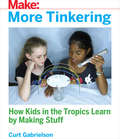- Table View
- List View
Monsoon Economies: India's History in a Changing Climate (History for a Sustainable Future)
by Tirthankar RoyHow interventions to mitigate climate-caused poverty and inequality in India came at a cost to environmental sustainability.In the monsoon regions of South Asia, the rainy season sustains life but brings with it the threat of floods, followed by a long stretch of the year when little gainful work is possible and the threat of famine looms. Beginning in the late nineteenth century, a series of interventions by Indian governments and other actors mitigated these conditions, enabling agricultural growth, encouraging urbanization, and bringing about a permanent decrease in death rates. But these actions—largely efforts to ensure wider access to water—came at a cost to environmental sustainability. In Monsoon Economies, Tirthankar Roy explores the interaction between the environment and the economy in the emergence of modern India. Roy argues that the tropical monsoon climate makes economic and population growth contingent on water security. But in a water-scarce world, the means used to increase water security not only created environmental stresses but also made political conflict more likely. Roy investigates famine relief, the framing of a seasonal &“water famine,&” and the concept of public trust in water; the political movements that challenged socially sanctioned forms of deprivation; water as a public good; water quality in cities; the shift from impounding river water in dams and reservoirs to exploring groundwater; the seasonality of a monsoon economy; and economic lessons from India for a world facing environmental degradation.
Monsoon Rains, Great Rivers and the Development of Farming Civilisations in Asia
by Peter D. Clift Jade d'Alpoim GuedesThe Asian monsoon and associated river systems supply the water that sustains a large portion of humanity, and has enabled Asia to become home to some of the oldest and most productive farming systems on Earth. This book uses climate data and environmental models to provide a detailed review of variations in the Asian monsoon since the mid-Holocene, and its impacts on farming systems and human settlement. Future changes to the monsoon due to anthropogenically-driven global warming are also discussed. Faced with greater rainfall and more cyclones in South Asia, as well as drying in North China and regional rising sea levels, understanding how humans have developed resilient strategies in the past to climate variations is critical. Containing important implications for the large populations and booming economies in the Indo-Pacific region, this book is an important resource for researchers and graduate students studying the climate, environmental history, agronomy and archaeology of Asia.
Monsters, Catastrophes and the Anthropocene: A Postcolonial Critique (Routledge Environmental Humanities)
by Gaia GiulianiMonsters, Catastrophes and the Anthropocene: A Postcolonial Critique explores European and Western imaginaries of natural disaster, mass migration and terrorism through a postcolonial inquiry into modern conceptions of monstrosity and catastrophe. This book uses established icons of popular visual culture in sci-fi, doomsday and horror films and TV series, as well as in images reproduced by the news media to help trace the genealogy of modern fears to ontologies and logics of the Anthropocene. By logics of the Anthropocene, the book refers to a set of principles based on ontologies of exploitation, extermination and natural resource exhaustion processes determining who is worthy of benefiting from value extraction and being saved from the catastrophe and who is expendable. Fears for the loss of isolation from the unworthy and the expendable are investigated here as originating anxieties against migrants’ invasions, terrorist attacks and planetary catastrophes, in a thread that weaves together re-emerging ‘past nightmares’ and future visions. This book will be of great interest to students and academics of the Environmental Humanities, Human and Cultural Geography, Political Philosophy, Psychosocial Studies, Postcolonial Studies and Critical Race and Whiteness Studies, Gender Studies and Postcolonial Feminist Studies, Cultural Studies, Sociology, Cultural Anthropology, Cinema Studies and Visual Studies.
Monstrous Nature and Representations of Environmental Harms: A Green Cultural Criminological Perspective
by Avi Brisman Nigel SouthHow does culture influence human relationships with the environment? In Monstrous Nature and Representations of Environmental Harms, green cultural criminologists Avi Brisman and Nigel South examine stories of monsters and disasters to address how the ways we depict and think about harms to the environment dissuade us from taking care of our planet and each other. The authors use examples from popular culture, including Disney and Marvel Cinematic Universe films, to consider ideas about how the environment responds to people who cause it harm. Brisman and South identify and discuss three dominant and interrelated depictions of the relationship between humans and the environment: first, nature as monstrous or fear inducing; second, nature and the Earth (or parts of it) as abject; and third, the entanglement of nature and the apocalypse, wherein nature is contributing to the end of the world, with an end point sometimes conceptualized as one without humans. Monstrous Nature and Representations of Environmental Harms argues that such representations have material consequences. The authors make the case for challenging them so that we neither perpetuate them nor retreat into cynicism and defeatism about the future of our planet.
Montana Duck Hunting Tales (Sports)
by Matt WempleDucks across the Big Sky To hunt ducks in Montana--where the land breathes history--is to experience extremes in geography, weather and wildlife. The breadth of mountains and prairie is unlike anywhere else in the Lower 48. Both the Central and Pacific flyways span the state's iconic wetlands, rivers and lakes. Hunting opportunities abound thanks to the state's wildlife conservation legacy on public and private lands. Hunters walk in the footsteps of plains Indians, Lewis and Clark and mountain men while looking for a spot to pitch decoys. Embark on an epic and distinct Big Sky journey with author and hunter Matt Wemple, where a moose or grizzly bear could stroll through the decoys at any time.
Monte Carlo N-Particle Simulations for Nuclear Detection and Safeguards: An Examples-Based Guide for Students and Practitioners
by John S. Hendricks Martyn T. Swinhoe Andrea FavalliThis open access book is a pedagogical, examples-based guide to using the Monte Carlo N-Particle (MCNP®) code for nuclear safeguards and non-proliferation applications. The MCNP code, general-purpose software for particle transport simulations, is widely used in the field of nuclear safeguards and non-proliferation for numerous applications including detector design and calibration, and the study of scenarios such as measurement of fresh and spent fuel. This book fills a gap in the existing MCNP software literature by teaching MCNP software usage through detailed examples that were selected based on both student feedback and the real-world experience of the nuclear safeguards group at Los Alamos National Laboratory. MCNP input and output files are explained, and the technical details used in MCNP input file preparation are linked to the MCNP code manual. Benefiting from the authors’ decades of experience in MCNP simulation, this book is essential reading for students, academic researchers, and practitioners whose work in nuclear physics or nuclear engineering is related to non-proliferation or nuclear safeguards. Each chapter comes with downloadable input files for the user to easily reproduce the examples in the text.
Monte Carlo Simulation in Statistical Physics: An Introduction (Graduate Texts in Physics #Vol. 80)
by Kurt Binder Dieter W. HeermannThe sixth edition of this highly successful textbook provides a detailed introduction to Monte Carlo simulation in statistical physics, which deals with the computer simulation of many-body systems in condensed matter physics and related fields of physics and beyond (traffic flows, stock market fluctuations, etc.). Using random numbers generated by a computer, these powerful simulation methods calculate probability distributions, making it possible to estimate the thermodynamic properties of various systems. The book describes the theoretical background of these methods, enabling newcomers to perform such simulations and to analyse their results. It features a modular structure, with two chapters providing a basic pedagogic introduction plus exercises suitable for university courses; the remaining chapters cover major recent developments in the field.This edition has been updated with two new chapters dealing with recently developed powerful special algorithms and with finite size scaling tools for the study of interfacial phenomena, which are important for nanoscience. Previous editions have been highly praised and widely used by both students and advanced researchers.
Monte Carlo Simulations Using Microsoft EXCEL® (Synthesis Lectures on Mathematics & Statistics)
by Shinil ChoThis book offers step-by-step descriptions of various random systems and explores the world of computer simulations. In addition, this book offers a working introduction to those who want to learn how to create and run Monte Carlo simulations. Monte Carlo simulation has been a powerful computational tool for physics models, and when combined with the programming language Excel, this book is a valuable resource for readers who wish to acquire knowledge that can be applied to more complex systems. Visualization of the simulation results via the Visual Basic built in Microsoft EXCEL is presented as the first step towards the subject. Prior experience with the Excel add-in VBA is kept to a minimum. In addition, a chapter on quantum optimization simulation utilizing Python is added to explore the quantum computation. Readers will gain a fundamental knowledge and techniques of simulation physics, which can be extended to STEM projects and other research projects.
Montology Palimpsest: A Primer of Mountain Geographies (Montology #1)
by Fausto O. SarmientoThis book introduces an innovative approach to sustainable and regenerative mountain development. Transdisciplinary to biophysical and biocultural scales, it provides answers to the "what, when, how, why, and where" that researchers question on mountains, including the most challenging: So What! Forwarding thinking in its treatment of core subjects, this decolonial, non-hegemonic volume inaugurates the Series with contributions of seasoned montologists, and invites the reader to an engaging excursion to ascend the rugged topography of paradigms, with the scaffolding hike of ambitious curiosity typical of mountain explorers.Chapter 8 is available open access under a Creative Commons Attribution 4.0 International License via link.springer.com.
Moon-Based Synthetic Aperture Radar: A Signal Processing Prospect (SAR Remote Sensing)
by Kun-Shan Chen Zhen XuLunar explorations have received increasing attention in recent years with tremendous application values, including using the Moon as a remote sensing platform for Earth observation. As an active sensor, the Synthetic Aperture Radar (SAR) can detect changes in the atmosphere, terrain, and ocean. Moon-based SAR, complementary to the spaceborne SAR systems, expands our capabilities of watching and understanding the Earth. This book explains the Moon-Earth observation geometry, generic parameters, image focusing, and outlook using the Moon-based SAR. Written as a SAR imaging of Earth on the lunar-based platform, it makes it an essential reference to those interested in planetary and Earth sciences.FEATURES Uses the Moon as a remote sensing platform for Earth observation Explains how to obtain a high spatial resolution with a short revisit time using the Moon-based SAR Covers the observation geometry, range and signal models, two-dimensional signal spectrum, and focusing algorithms for the Moon-based SAR Presents a detailed analysis of sources of phase errors in the Moon-based SAR signal Includes global case studies and introduces conceptual ideas for further research This book is intended for senior graduate students, professional researchers, and engineers studying and working in the fields of lunar exploration and remote sensing applications, especially when dealing with high-orbit SAR studies.
Moraine State Park (Images of Modern America)
by Polly ShawAbout 20,000 years ago, the late Wisconsinan glaciation reached its maximum extent. Glacial deposits identify the moraine, or farthest area covered by the glacier. Muddy Creek was a north-flowing stream that was blocked by the south-advancing glacier, forming a huge lake that lasted until the glacier dam began to retreat. The lake rapidly drained, eventually exposing the vast Muddy Creek basin. Dr. Frank Preston envisioned recreating the ancient glacial lake and worked with the Western Pennsylvania Conservancy to begin the project that became 16,725-acre Moraine State Park. Its centerpiece, man-made Lake Arthur and the surrounds, provide outstanding outdoor recreation and relaxation opportunities.
Moral Ground
by Kathleen Dean Moore Michael P. Nelson<P>Moral Ground brings together the testimony of over eighty visionaries-theologians and religious leaders, scientists, elected officials, business leaders, naturalists, activists, and writers-to present a diverse and compelling call to honor our individual and collective moral responsibility to our planet. In the face of environmental degradation and global climate change, scientific knowledge alone does not tell us what we ought to do. The missing premise of the argument and much-needed center piece in the debate to date has been the need for ethical values, moral guidance, and principled reasons for doing the right thing for our planet, its animals, its plants, and its people. <P>Contributors from throughout the world (including North America, Africa, Australia, Asia, and Europe) bring forth a rich variety of heritages and perspectives. Their contributions take many forms, illustrating the rich variety of ways we express our moral beliefs in letters, poems, economic analyses, proclamations, essays, and stories. In the end, their voices affirm why we must move beyond a scientific study and response to embrace an ongoing model of repair and sustainability. These writings demonstrate that scientific analysis and moral conviction can work successfully side-by-side. <P>This is a book that can speak to anyone, regardless of his or her worldview, and that also includes a section devoted to "what next" thinking that helps the reader put the words and ideas into action in their personal lives. Thanks to generous support from numerous landmark organizations, such as the Kendeda Fund and Germeshausen Foundation, the book is just the starting point for a national, and international, discussion that will be carried out in a variety of ways, from online debate to "town hall" meetings, from essay competitions for youth to sermons from pulpits in all denominations. The "Moral Ground movement" will result in a newly discovered, or rediscovered, commitment on a personal and community level to consensus about our ethical obligation to the future.
Moral Responsibility and Risk in Society: Examples from Emerging Technologies, Public Health and Environment (Earthscan Risk in Society)
by Jessica Nihlén FahlquistRisks, including health and technological, attract a lot of attention in modern societies, from individuals as well as policy-makers. Human beings have always had to deal with dangers, but contemporary societies conceptualise these dangers as risks, indicating that they are to some extent controllable and calculable. Conceiving of dangers in this way implies a need to analyse how we hold people responsible for risks and how we can and should take responsibility for risks. Moral Responsibility and Risk in Society combines philosophical discussion of different concepts and notions of responsibility with context-specific applications in the areas of health, technology and environment. The book consists of two parts addressing two crucial aspects of risks and responsibility: holding agents responsible, i.e. ascribing and distributing responsibility for risks, and taking responsibility for risk. More specifically, the book discusses the values of fairness and efficacy in responsibility distributions and makes distinctions between backward-looking and forward-looking responsibility as well as individual and collective responsibility. Additionally, it analyses what it means to take responsibility for technological risks, conceptualising this kind of responsibility as a virtue, and furthermore, explores the notion of responsible risk communication and the implications for adult-child relationships. This book will be of great interest to students and scholars of environmental ethics, bioethics, public health ethics, engineering ethics, philosophy of risk and moral philosophy.
Moralizing The Environment: Countryside change, farming and pollution
by Susanne Seymour Philip Lowe Judy Clark Neil WardFirst published in 1997. There was a time when pollution was equated with the urban and the industrial. But things have changed. What were previously mutually exclusive categories of "agriculture" and "pollution" have been brought together in a new, morally charged atmosphere. Moralizing the environment is a study of how this shift came about. It examines the emergence of the farm pollution problem in Britain in the 1980s. It draws upon a study of the regulation of farm wastes - cattle slurry, silage effluent and the dirty water from farmyards - conducted between 1989 and 1995. Detailed surveys and ethnographic fieldwork were carried out in the south-west of England among dairy farmers, pollution inspectors, agricultural advisers and environmentalists. In trying to get to grips with farm pollution they were pursuing different notions not only of sound agricultural practice but also of nature, morality and the law. What ultimately was at stake was who could be trusted to safeguard the countryside.
More Deadly Than War: The Hidden History of the Spanish Flu and the First World War (Chicka Chicka Book)
by Kenneth C. DavisA Washington Post Best Children’s Book of the Month, More Deadly Than War from New York Times bestselling author Kenneth C. Davis explores the hidden history of the Spanish influenza pandemic during World War I.2018 marked the 100th anniversary of the worst disease outbreak in modern times: the Spanish flu, a story even more relevant today. This dramatic narrative, told through the stories and voices of the people caught in the deadly maelstrom, explores how this vast, global epidemic was intertwined with the horrors of World War I—and how it could happen again. Complete with photographs, period documents, modern research, and firsthand reports by medical professionals and survivors, More Deadly Than War provides captivating insight into a catastrophe that transformed America in the early twentieth century.A Junior Library Guild Selection!“An important history—and an important reminder that we could very well face such a threat again.”—Deborah Blum, New York Times bestselling author of The Poison Guide: One Chemist’s Single-Minded Crusade for Food Safety at the Turn of the Twentieth Century“In an age of Ebola and Zika, this vivid account is a cautionary tale that will have you rushing to wash your hands for protection.”—Karen Blumenthal, award-winning author of Jane Against the World: Roe v. Wade and the Fight for Reproductive Rights
More From Less: The surprising story of how we learned to prosper using fewer resources – and what happens next
by Andrew McAfeeBestselling author and co-director of the MIT Initiative on the Digital Economy Andrew McAfee says there’s a new reason for optimism: we’re past the point of 'peak stuff' - from here on out, it’ll take fewer resources to make things, and cost less to lead a comfortable life. This turn of events invalidates the predictions of overpopulation alarmists and those who argue we need to drastically reduce our conception of how much is enough. What has made this turnabout possible? One thing primarily: the collaboration between technology and capitalism. Capitalism’s quest for higher profits is a quest for lower costs; materials and resources are expensive, and technological progress allows companies to use fewer of them even as they grow their markets. Modern smartphones take the place of cameras, GPS units, landline telephones, answering machines, tape recorders and alarm clocks. Precision agriculture lets farmers harvest larger crops while using less water and fertiliser. Passenger cars get lighter, which makes them cheaper to produce and more fuel-efficient. This means that, even though there’ll be more people in the future, and they’ll be wealthier and consume more, they’ll do so while using fewer natural resources. For the first time ever, and for all time to come, humans will live more prosperous lives while treading more lightly on the Earth. The future is not all bright, cautions McAfee. He warns of issues that still haven’t been fully solved. (For example, our oceans are still vulnerable to overfishing; global warming is still running largely unchecked; and even as 'dematerialisation' - the reduced need for raw materials - improves our global situation, power and resources are getting more concentrated. That creates an even larger division between the haves and the have nots.)More From Less is a revelatory, paradigm-shifting account of how we’ve stumbled into an unexpected balance with nature, and the possibility that our most abundant centuries are ahead of us.
More Good News
by David Suzuki Holly DresselIn this edition of their bestseller, the sequel to the best-selling Good News for a Change, authors David Suzuki and Holly Dressel provide the latest inspiring stories about individuals, groups, and businesses that are making real change in the world. More Good News features the most up-to-date information about critical subjects, such as energy and the economy, not covered in the previous edition. These stories offer compelling proof from the front lines that sustainable solutions already exist.
More Heat than Life: The Tangled Roots of Ecology, Energy, and Economics
by Jeremy WalkerThis book traces the interacting histories of the disciplines of ecology and economics, from their common origin in the ancient Greek concept of oikonomia, through their distinct encounters with energy physics, to the current obstruction of neoliberal economics to responses to the ecological and climate crisis of the so-called Anthropocene. Reconstructing their constitution as separate sciences in the era of fossil-fuelled industrial capitalism, the book offers an explanation of how the ecological sciences have moved from a position of critical collision with mainstream economics in the 1970s, to one of collusion with the project of permanent growth, in and through the thermal crisis of the biosphere.
More Plants Less Waste: Plant-based Recipes + Zero Waste Life Hacks with Purpose
by Max La MannaDELICIOUS PLANT-BASED RECIPES TO WASTE LESS FOOD!Max La Manna, low waste chef and climate activist, bridges the gap between vegan food and waste-free cooking - inviting us to channel the MORE PLANTS LESS WASTE mindset and discover a stronger purpose in the kitchen and in our daily routines. --Through his viral recipe videos and work with BBC Earth and beyond, Max has inspired hundreds of thousands of people across the world to rethink their approach to food consumption and made it his mission to breathe new life into our leftovers that are typically destined for the bin. In his first cookbook he shares 80 of his tastiest, healthy recipes that are bursting with flavour, will help you save money, food and ensure you eat well - from Sumptuous Spag Bol and Vegan Shepherd's Pie to Pumpkin Pasta, Crunchy Cauliflower Curry or Leftover Veggie Nachos in a Hurry.. MORE PLANTS->LESS WASTE INCLUDES: - simple, accessible ingredients that celebrate the power of vegetables and wholefoods at their best- breakfasts, lunches, dinners, soups, stews and salads - plus sweet treats- all-natural home hacks from DIY deodorant to Citrus Bomb House Cleanser - the life tools you need to add value to what you already own and set you on the path to living more sustainably - a 21-day zero waste challenge
More Plants Less Waste: Plant-based Recipes + Zero Waste Life Hacks with Purpose
by Max La MannaMax La Manna, zero waste chef and sustainability advocate, bridges the gap between vegan food and waste-free cooking - inviting us to channel the MORE PLANTS LESS WASTE mindset and discover a stronger purpose in our daily routines. --Max has inspired thousands of people across the world to rethink their approach to consumption and made it his mission to turn the tide on plastic and breathe new energy into the leftovers that are typically destined for the bin. In his first cookbook he will share 80 of his tasty, healthy recipes that will have your taste buds watering, help you save money, food and eat well from Sumptuous Spag Bol and Crunchy Cauliflower Curry to Leftover Veggie Nachos in a Hurry.. MORE PLANTS->LESS WASTE INCLUDES: - simple, accessible ingredients that celebrate the power of plants and wholefoods at their best- all-natural home hacks from DIY deodorant to Citrus Bomb House Cleanser - the life tools you need to add value to what you already own and set you on the path to living more sustainably - a 21-day zero waste challenge--With a little more thought we can all make small changes that will have a BIG, positive impact on the health of our planet. --
More Precious than Gold
by Tracy Vonder BrinkAluminum was once more valuable than gold. A breakthrough in refining aluminum from rock transformed it from rare matter to sandwich wrapper. In this science story, you'll learn how two chemists, Charles Hall and Paul Héroult, solved the problem.
More Straw Bale Building
by Peter Mack Chris MagwoodStraw bale houses are easy to build, affordable, super energy efficient, environmentally friendly, attractive, and can be designed to match the builder's personal space needs, esthetics and budget. Despite mushrooming interest in the technique, however, most straw bale books focus on "selling" the dream of straw bale building, but don't adequately address the most critical issues faced by bale house builders. Moreover, since many developments in this field are recent, few books are completely up to date with the latest techniques.More Straw Bale Building is designed to fill this gap. A completely rewritten edition of the 20,000-copy best--selling original, it leads the potential builder through the entire process of building a bale structure, tackling all the practical issues: finding and choosing bales; developing sound building plans; roofing; electrical, plumbing, and heating systems; building code compliance; and special concerns for builders in northern climates. New material includes:more extensive sections on electric wiring and plumbingupdated sections on bale finishes and finishinga section on prefabricated straw bale wallsa wider selection of case studies, photographs and illustrationsa section on common mistakesbudgeting for low-, medium- and high-cost projects, and new testing data that is in no other straw bale book.Down-to earth and complete, More Straw Bale Building makes the remarkable benefits of straw bale building available in the most comprehensive and practical book on the subject to date.Chris Magwood and Peter Mack are professional straw bale house builders and consultants who have constructed over 40 straw bale structures and have taught workshops and seminars in several countries. Chris is editor of The Last Straw Journal, an international quarterly devoted to straw-bale building, and the coauthor of Straw Bale Details: A Manual for Designers and Builders (New Society Publishers, 2003).
More Tinkering: How Kids in the Tropics Learn by Making Stuff
by Curt GabrielsonTinkering is a way of learning through hands-on activity -- experimenting with materials and devices to see how they work, taking things apart, making small changes and improvements, exploring and inventing. Tinkering may seem like a form of play -- and it is -- but it is also a powerful way of discovering truths about science, engineering, and math. With this book, Curt Gabrielson follows up on his best-seller Tinkering: Kids Learn by Making Stuff with this all-new volume that features more than three dozen fun and educational tinkering projects based on his years of working with kids in the tropical island nation of Timor-Leste. Step-by-step instructions accompanied by full-color photos take you through a range of enjoyable projects that explore life sciences, physics, chemistry, earth sciences, and mathematics. You'll discover how math is used to make baskets, how fungi create fermentation, how electricity can make a magnet, how the greenhouse effect creates warming, and much more. The author also enlivens his latest batch of tinkering projects with colorful tales of his experiences in the tropic and the lives of the people he' s met there.Inside you'll find:Clear directions for making simple projects and doing activities that teach science, mathematics and engineeringProjects rooted in day to day life and experience in a small, developing nation in the Asian tropicsFull-color photographs throughoutExplicit connections to standard STEAM concepts, K-12Activities doable with less than $5 worth of common materialsThis book is perfect for parents, teachers, and students with an interest in hands-on, tinkering-based science and mathematics education, whether in traditional schools or in home-schooling situations. It will also be of interest to anyone who wants to learn more about developing nations, the culture and unique history of Timor-Leste, tropical nations or Asian cultures, with specific links to Indonesia, Portugal, or Australia.
More from Less: The Surprising Story of How We Learned to Prosper Using Fewer Resources—and What Happens Next
by Andrew McAfeeFrom the coauthor of the New York Times bestseller The Second Machine Age, a compelling argument—masterfully researched and brilliantly articulated—that we have at last learned how to increase human prosperity while treading more lightly on our planet. Throughout history, the only way for humanity to grow was by degrading the Earth: chopping down forests, fouling the air and water, and endlessly digging out resources. Since the first Earth Day in 1970, the reigning argument has been that taking better care of the planet means radically changing course: reducing our consumption, tightening our belts, learning to share and reuse, restraining growth. Is that argument correct? Absolutely not. In More from Less, McAfee argues that to solve our ecological problems we don’t need to make radical changes. Instead, we need to do more of what we’re already doing: growing technologically sophisticated market-based economies around the world. How can he possibly make this claim? Because of the evidence. America—a large, high-tech country that accounts for about 25% of the global economy—is now generally using less of most resources year after year, even as its economy and population continue to grow. What’s more, the US is polluting the air and water less, emitting fewer greenhouse gases, and replenishing endangered animal populations. And, as McAfee shows, America is not alone. Other countries are also transforming themselves in fundamental ways. What has made this turnabout possible? One thing, primarily: the collaboration between technology and capitalism, although good governance and public awareness have also been critical. McAfee does warn of issues that haven’t been solved, like global warming, overfishing, and communities left behind as capitalism and tech progress race forward. But overall, More from Less is a revelatory, paradigm-shifting account of how we’ve stumbled into an unexpectedly better balance with nature—one that holds out the promise of more abundant and greener centuries ahead.
More than the Soil: Rural Change in SE Asia
by Jonathan RiggMore than the Soil focuses on the social, cultural, economic and technological processes that have transformed rural areas of Southeast Asia. The underlying premise is that rural lives and livelihoods in this region have undergone fundamental change. No longer can we assume that rural livelihoods are founded on agriculture; nor can we assume that people envisage their futures in terms of farming. The inter-penetration of the rural and urban, and the degree to which rural people migrate between rural and urban areas, and shift from agriculture to non-agriculture, raises fundamental questions about how we conceptualise the rural Southeast Asia and the households to be found there.
